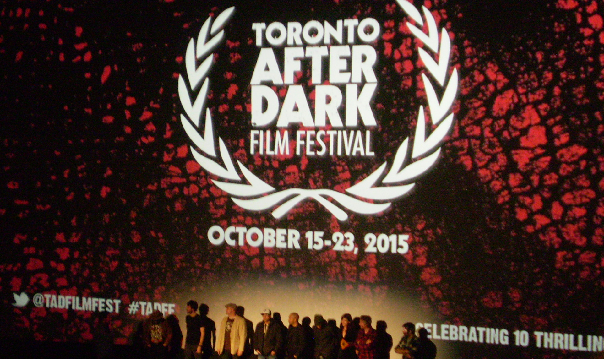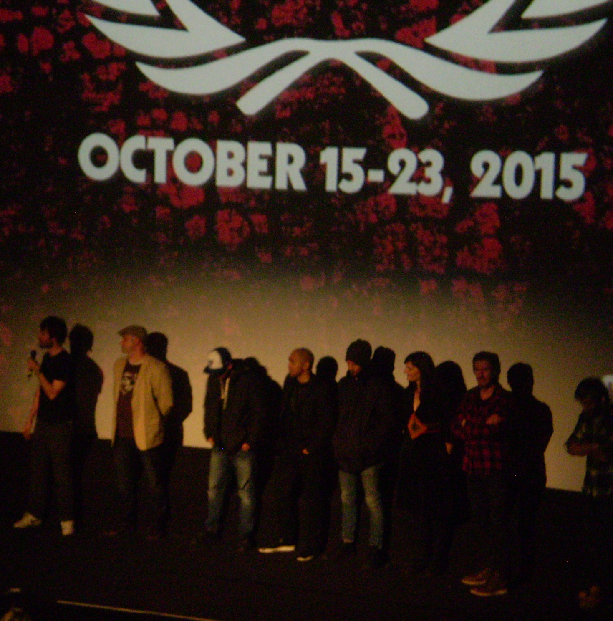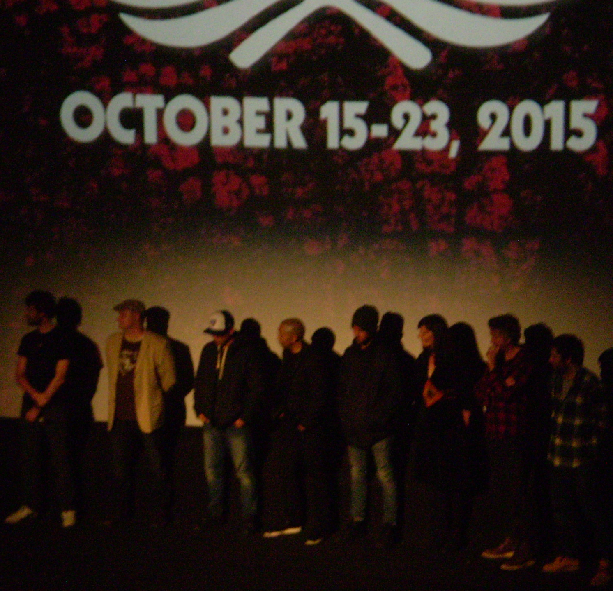Fearlessly setting out on a physically and emotionally daunting experience, no matter how terrifying the journey and consequences may appear to be, can be the most revealing way for people to truly discover who they really are, and what they’re meant to do. Not only is that telling exploration a meaningful one for first-time feature film writer, director, producer and editor Trevor Juras, who courageously made the leap into features after working on four shorts over the past two years, but also for the troubled anti-hero in his initial feature. The helmer daringly crafted an intriguingly flawed main character whose beliefs are still alluringly relatable in the new Canada-set and produced horror crime drama, ‘The Interior.’
To celebrate that humble internal examination into where life should take everyone, the movie had a sold out crowd during its Toronto premiere at the Scotiabank Theatre this past Monday (October 19) night at the 10th Annual Toronto After Dark Film Festival (TADFF). To celebrate ‘The Interior’ being showcased in Toronto, where the beginning of its story is set, Juras, along with several members of the cast and crew, generously participated in a post-screening Q&A, which was hosted by one of TADFF’s programmers, Justin McConnell.
‘The Interior’ opens with disgruntled office worker James (Patrick McFadden) visiting his doctor (Delphine Roussel) at her office, and explaining his increasingly mysterious symptoms, which include double vision and numbness in his hands. The symptoms, which are connected to his stress, apathy, depression and unhappiness with his life, are revealed to be an indication of a serious, but unnamed, illness. As a result of his general disengagement from his office job, including his discontent with his boss, Mr. Vondas (Andrew Hayes), James decides to make a drastic change in his life, and purposely gets himself fired. After then trying to change lifestyles and work as a mechanic, he feels compelled to leave his latest job again, as he suddenly feels drawn to leave Toronto.
Much to the disappointment of Cindy (Shaina Silver-Baird), whom he recently dated for a year before they agreed to try taking some time apart, James then decides to go camping alone in the wilderness of British Columbia. When he then first arrives in the woods, James finds the serenity he was seeking, but his comfort soon begins to dwindle when he sees a mysterious man, who’s simply known as Red Coat (Jake Beczala). Jams believes the other man is deliberately targeting him, particularly after his items are mysteriously moved, and his tent gets sabotaged. As he quickly descends into paranoia, James must not only figure out if what he’s seeing is real, but also how to protect himself, both physically and emotionally.
McConnell kicked off ‘The Interior’s post-screening Q&A at TADFF by asking Juras how he came up with the idea for the horror movie. The filmmaker laughed as he revealed that after he decided that he wanted to write and direct a horror movie, the inspiration “came from my own life a little bit. It’s a parody and exaggeration of my life, and also includes observations I made over the years.”
One of ‘The Interior’s producers, Peter Kuplowsky, then explained to McConnell that he became attached to the drama two years ago, after he programmed one of Juras’ short films, ‘The Lamp,’ which also was showcased at TADFF. “It was one of the scariest (shorts) I have ever seen,” the producer revealed. “Yet, there wasn’t any violence or gore, or any literal or physical monsters.” He added that he liked the horrific aspects of the short came “entirely from suggestion through Trevor’s direction, the performances and the editing. So I just wanted to be friends with this guy.”
After Juras then attended film school in Los Angeles after making ‘The Lamp,’ Kuplowsky noted that the scribe-helmer was “super-charged by the experience. So I was hoping that he’d then say, ‘I want to make a feature. Will you help me?’ When he did say those words, I was so honored and privileged.”
The producer added that he was excited to work on ‘The Interior.’ When the two first met to discuss the feature, Juras told Kuplowsky that he wanted to make a unique lost in the woods film. “At that point, I think Trevor decided that he wanted (James) to be by himself. There wouldn’t be any conversations about how (he’s) lost, and are going around in circles. It was just him by himself, and how long we could sustain that tension,” Kuplowsky further explained about how they created the story.
Juras also described his writing as being sarcastic, as he feels it’s nice to hear viewers laugh, even throughout such intense scenes as when James is helplessly isolated in the woods. “Even when nothing’s being said, people are still giggling at the film. I think that’s just my style,” he explained. The writer-director then revealed that some of the filmmakers who have influenced his overall career include David Lynch, Stanley Kubrick and Paul Thomas Anderson, “but I can’t think of anyone who directly inspired this film.”
When then asked by McConnell how he brought the horror film’s cast together, Juras divulged that he “didn’t audition anyone for this. I wrote the parts with everyone in mind. Take Ryan (Austin) here, who played Roland-he’s not an actor, but he’s awesome. I wrote the part exactly for him.” The filmmaker then noted that the cast was largely a culmination of the actors he had previously worked with on his short films. “Everyone was available and willing to take parts in ‘The Interior.’ I thought everyone was able to pull off their roles,” Juras added.
Austin then revealed that some of his dialogue throughout the horror film was written for him. However, Juras did let him “go off a little bit at the end. We discussed a couple of lines here and there, but for the most part, it was written.”
Hayes added that he also took some freedom in shaping his character. To show that Mr. Vondas is a boss that James dislikes and looks down upon, Hayes revealed that he would take such drastic measures as showing up to the set with his hair looking extremely greasy.
Juras then jumped in and laughed as he divulged that “My favorite thing that Patrick did was when he walked into the room after (James) messed up the report, and Andrew is trying on two different glasses. I just loved that.”
Also discussing how she became involved in the drama, Rousse explained that she initially only knew the director was filming the woods scenes in British Columbia before her character’s scenes were going to be shot. When the wood scenes were finished, Juras approached the actress and asked her if she wanted to play James’ doctor in a couple of scenes. “I was excited (about the role), because I wasn’t being tortured or crying, so that was a lovely challenge for me,” the performer laughed as she noted her enthusiasm for the normal role of the well-adjusted doctor.
Further discussing the process of acting in ‘The Interior,’ McFadden disclosed that “The scariest thing happened before we left. Trevor was saying that there were these two cougars that kept swimming between Salt Spring Island and Vancouver Island,” where the crime drama filmed.
So the director would warn the cast and crew that if they saw one cougar, they should be careful, because “there would be another one behind you, and it will jump on you.” The actor laughed as he said, “One (cougar) sets you up, and the other one takes you down.” So during a lot of the scenes where James is looking around the forest, “I didn’t even know if the camera was rolling. I was just checking to make sure there weren’t any cougars. So that was pretty helpful.”
With the majority of James’ isolated journey throughout the woods taking place at night, Othello J. Ubalde, who made his cinematography and producing debuts on ‘The Interior,’ explained that he used a single light source, Phoenix flashlights, to illuminate the scenes. He was never truly worried about whether or the flashlights could adequately light the set and scenes, as he explained they were strong enough to brighten two football fields when needed. But “It was (also) really important to us that we didn’t have night scenes that were overly lit with a bright moon, and that we weren’t lighting the whole forest. We wanted the darkness to look real, like how it does when you’re really out there camping, when all you have is a flashlight,” he also admitted. During the sequences in the woods, ‘The Interior’s Director of Photography added that there were several key crew members who helped him tremendously, including his First AC (the chief camera assistant).
When then asked by an audience member why James didn’t speak to Red Jacket during his journey in the woods, Juras said “I guess he never really had the opportunity. (Red Jacket) was far away, and (James) was also worried that this was someone he could have possible stolen something from. So James never really wanted, or was able to, engage in conversation with him.” Further explaining the meaning behind Red Jacket, Juras revealed that “I look at it as a metaphor of a fear of illness and wasting time. The man in the red jacket is a literal example of his fears and anxieties.”
Juras answered another audience member’s question when he explained why he chose to emphasize James’ isolation from his friends, colleagues and society in general during his time in the woods, instead of in Toronto. “When you’re out in the woods, you’re exposed by nature, whereas in the city, you can hide. James is hiding behind narcissism and drug use (in the city), but out in nature, everything is laid bare,” the scribe-helmer said. “If something’s bothering you, there’s just no hiding it, because it’s just life and death all around you.”
Check out Shockya’s exclusive photos from ‘The Interior’s Toronto After Dark Film Festival post-screening Q&A below.
Written by: Karen Benardello



